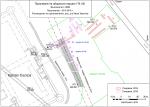Summary (English)
SOSTRA (Ivan Hristov – ivchristov70@abv.bg) Explorations were carried out in front of the eastern fortification wall of castellum Sostra. A sector of the Roman road was explored, 7 m wide and with two lanes. The road was paved with slabs 10 – 20 cm thick, which were placed over a layer of boulders c. 20 cm thick. There was a trampled layer of rubble up to 10 cm thick spread beneath the boulders. Bronze colonial coins were found between the boulders, minted by Septimius Severus, Elagabalus, Severus Alexander and Gordian III in Marcianopolis, Nicopolis ad Istrum, Pautalia and Hadrianopolis. The coins were found as single items and hoards from 9 to 45 coins. A layer containing debris from Late Antique buildings (fragmentary building ceramics, pieces of charcoal) and coins of Theodosius I and Arcadius was discovered over the road. A sondage was carried out between the road and the fortification wall of the end of the 2nd century AD. Debris of the fortification wall of the end of the 3rd century AD and debris of the fortification wall of the end of the 2nd century AD were found. A colonna miliaria was discovered. It had a Latin inscription that reads: “To Emperor Caesar Marcus Iulius Philippus pious, fortunate Augustus, great Persian, great Parthian, with Tribunal power, father of the fatherland, Proconsul, and to Marcus Iulius Philippus, the most noble Caesar, his son; with the cares of Prastina Messalinus, Augustan Legate, Propraetor. 1 mile”. The inscription dated to AD 244. The reason for the column to be erected might have been the passing of Philip the Arab through the Balkans during the summer of AD 244. The name of the Legate Prastina Messalinus is also known from a votive inscription devoted to Philip the Younger by Cohors I Cilicum in Sacidava and from provincial bronze coins of Philip the Arab minted in Marcianopolis.
- Ivan Hristov - National Museum of History
Director
Team
Research Body
- National Museum of History






![Download [PDF]](/excavation/skins/fasti/images/results/download_sml.png)
